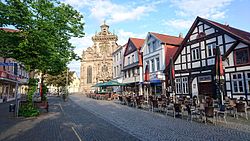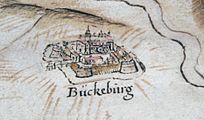world.wikisort.org - Germany
Bückeburg (Northern Low Saxon: Bückeborg) is a town in Lower Saxony, Germany, on the border with North Rhine Westphalia. It is located in the district of Schaumburg close to the northern slopes of the Weserbergland ridge. Population: 21,030.[3]
Bückeburg | |
|---|---|
Town | |
 Long Street with the Lutheran Bückeburg Church | |
 Flag  Coat of arms | |
Location of Bückeburg within Schaumburg district  | |
 Bückeburg  Bückeburg | |
| Coordinates: 52°15′39″N 09°02′57″E | |
| Country | Germany |
| State | Lower Saxony |
| District | Schaumburg |
| Subdivisions | 13 |
| Government | |
| • Mayor (2021–26) | Axel Wohlgemuth[1] (CDU) |
| Area | |
| • Total | 68.84 km2 (26.58 sq mi) |
| Elevation | 63 m (207 ft) |
| Population (2020-12-31)[2] | |
| • Total | 19,351 |
| • Density | 280/km2 (730/sq mi) |
| Time zone | UTC+01:00 (CET) |
| • Summer (DST) | UTC+02:00 (CEST) |
| Postal codes | 31675 |
| Dialling codes | 05722 |
| Vehicle registration | SHG |
| Website | www.bueckeburg.de |

History
Bückeburg was once the capital of the tiny principality of Schaumburg-Lippe. Houses began to gather around the castle c. 1365 and were protected by a city wall in the 17th century. In the 19th century, it was connected to the Minden and Hanover Railway and housed a synagogue.[4] The poet J. G. von Herder was court preacher here from 1771 to 1776.[5]
Bückeburg is a former British garrison town and had a number of British residents until recently. Most of the British residents worked at the British Military Hospital (BMH) in Rinteln, or in the local English Prince Rupert School, also in Rinteln. The number of British military residents in Bückeburg decreased significantly in the late 1990s, when BMH Rinteln closed down, however the staff of Prince Rupert School were still based in Bückeburg until the closure of the school in July 2014.
Buildings
Bückeburg Palace
Bückeburg Palace (Schloss Bückeburg) was the residence of the Princes of Schaumburg-Lippe. Although the Princely family surrendered political power in 1918, they still live there today. The palace, part of which is open to the public, is an important major tourist sight and houses important works of art and an important library. The history of the building spans 700 years, with the most important contributions stemming from the 16th, 17th, and 19th centuries.
- Drawing of Bückeburg along the Weser in 1520 during the Hildesheim Diocesan Feud, Drawing by Johannes Krabbe
- Bückeburg, gate: Schloss Bückeburg
The Princely Mausoleum in the palace grounds is open to the public as well. Built in 1915 in Neo-Romanic style and resembling the Roman Pantheon, it is the world's largest private sepulchre still in use. The cupola is adorned by an impressive gold mosaic, the second largest of its kind after the one in the Hagia Sophia.
In the period around 1950 when the Royal Air Force had a base nearby, the children of the service families attended a school in the Schloss.
Helicopter Museum
Bückeburg is also home to a helicopter museum, which features the early drawings of flying objects by Leonardo da Vinci as well as 40 actual helicopters. The German Army's Army Aviators School using Bückeburg Air Base is located here.
Bückeburg Church

The Town Church of Bückeburg (Bückeburger Stadtkirche) was one of the first Lutheran churches built after the Reformation. It is known for its pulpit and especially for the ornately decorated bronze-cast font, made by the Dutch artist Adriaen de Vries. Composer Johann Christoph Friedrich Bach (1732–1795), a son of J.S. Bach, worked at the Bückeburg court from before 1751 until his death, first as a harpsichordist, then, from 1759, as Konzertmeister (director) of the Hofkapelle (court orchestra) there. Bach is buried in the churchyard of the Stadtkirchengemeinde-Bückeburg. Bach set several texts by Johann Gottfried Herder, who was at the Bückeburg court as its superintendent and chief preacher from 1771–1776.
Transport
Bückeburg has a railway station and is served by line S1 of the Hanover S-Bahn. There are hourly train services between Bückeburg, Minden and Hanover.
Notable people

- Thomas Abbt (1738–1766), writer and philosopher, Government and consistorial council as well as Patronus scholarum
- Hans Blum (born 1928), pianist, bassist, composer, was trained at the Army Music School
- Horst Fischer (1930–1986), trumpeter, was trained at the Army Music School
- Johann Gottfried Herder (1744–1803), poet, theologian and philosopher, worked from 1771 to 1775 as the main preacher, superintendent and consistorial councilor in Bückeburg
- Wilhelm Külz (1875–1948), politician, was mayor from 1904 to 1912, from 1909 lord mayor in Bückeburg and in 1926 interior minister in the cabinets of chancellors Hans Luther and Wilhelm Marx
- James Last (1929–2015), bassist, composer and bandleader, was trained at the Army Music School
- Louise Lehzen (1784–1870), from 1814 to 1842 Gouvernante Queen Victoria lived from 1842 until her death in 1870 in Bückeburg
- Karl Lieffen (1926–1999), actor, was trained at the Army Music School
- Hermann Löns (1866–1914), journalist and writer, was from 1907 to 1909 editor of the Schaumburg-Lippische Landes-Zeitung (=newspaper)
- Timo Maas (born 1969), musician
- Iwan Müller (1786–1854), composer and instrument maker

- Les Scheinflug (born 1938), Australian international football player and coach of their national team
- Heinrich Strack (1805–1880), architect
- Ernst Torgler (1893–1963), politician, from 1929 to 1933 KPD faction chairman in Reichstag and one of the defendants in the Reichstagsbrand process, worked from 1945 until 1948 in the Bückeburg city administration
- August von Herder (1776–1838), geologist and mineralogist
- Karl von Plettenberg (1852–1938), general of the infantry, lived in Bückeburg
Notes
- "Stichwahlen zu Direktwahlen in Niedersachsen vom 26. September 2021" (PDF). Landesamt für Statistik Niedersachsen. 13 October 2021.
- Landesamt für Statistik Niedersachsen, LSN-Online Regionaldatenbank, Tabelle A100001G: Fortschreibung des Bevölkerungsstandes, Stand 31. Dezember 2020.
- "Bückeburg". Archived from the original on 2011-06-22. Retrieved 2010-01-07.
- EB (1878).
- EB (1911).
References
- Baynes, T. S., ed. (1878), , Encyclopædia Britannica, vol. 4 (9th ed.), New York: Charles Scribner's Sons, p. 415
- Chisholm, Hugh, ed. (1911), , Encyclopædia Britannica, vol. 4 (11th ed.), Cambridge University Press, p. 720
External links
- Official website
 (in German)
(in German) - Schloss Bückeburg
- Helicopter Museum Bückeburg
- Obernkirchen Children's Choir
На других языках
[de] Bückeburg
Bückeburg ist eine Stadt im niedersächsischen Landkreis Schaumburg mit rund 19.000 Einwohnern. Sie war ab 1640/47 Residenzstadt der Grafschaft Schaumburg-Lippe, ab 1807 des Fürstentums und von 1919 bis 1946 Hauptstadt des republikanischen Freistaats. Bückeburg liegt etwa 50 Kilometer westlich von Hannover und 10 Kilometer östlich von Minden am Höhenzug Harrl und grenzt westlich, südlich und nördlich unmittelbar an das Land Nordrhein-Westfalen. Die Stadt ist Sitz des Niedersächsischen Staatsgerichtshofes.- [en] Bückeburg
[es] Bückeburg
Bückeburg es una pequeña ciudad en la Baja Sajonia, Alemania. Fue una vez la capital del pequeño Principado de Schaumburg-Lippe y hoy se encuentra en el distrito de Schaumburg en las faldas septentrionales de las montañas Weserbergland.[ru] Бюккебург
Бюккебург (нем. Bückeburg) — город в Нижней Саксонии, в районе Шаумбург. Расположенный в 50 км к западу от Ганновера и в 10 км к востоку от Миндена, Бюккебург граничит с землёй Северный Рейн-Вестфалия на западе, юге и севере. Численность населения — около 19 тыс. чел. (2020).Другой контент может иметь иную лицензию. Перед использованием материалов сайта WikiSort.org внимательно изучите правила лицензирования конкретных элементов наполнения сайта.
WikiSort.org - проект по пересортировке и дополнению контента Википедии

